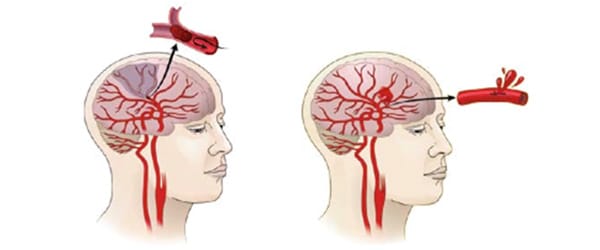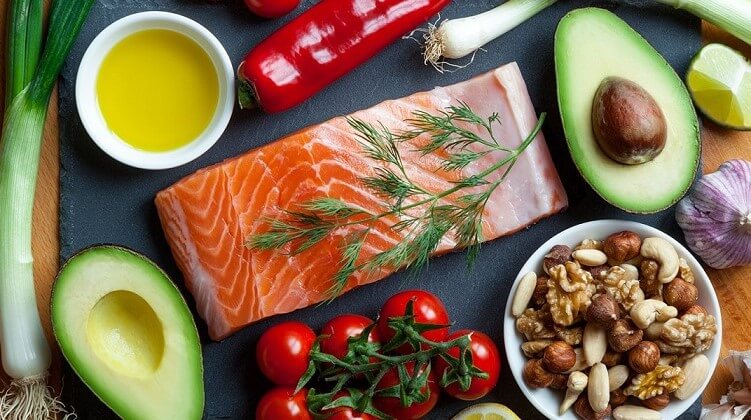Stroke risk is significantly influenced by nutrition, contrary to popular belief among medical professionals. Diet is the single most important contributor to an increased risk of stroke, yet only 0.1% of Americans eat a healthy diet and 8.3% eat a diet that is at least somewhat healthy.
Most other countries are probably not much better. High-risk patients can reduce their stroke risk by as much as 40 percent by adopting a Cretan Mediterranean diet high in legumes, fruits, vegetables, whole grains, and olive oil, whole grains, but low in saturated fat and cholesterol.
The intestinal bacteria found in egg yolk and red meat produce pretty high toxic metabolites which are renally excreted and highlights how intestinal microbiomes can potentially be risky to one’s cardiovascular health.
In order to reduce the risk of stroke, patients with renal impairment, such as the elderly, are required to avoid egg yolk and eat less red meat. Ideally, you should also limit your daily salt intake to between 2 and 3 grams only.
The lack of metabolic vitamin B12 in one’s daily diet is also a common mistake that could have grave consequences, as it can cause severe neurological repercussions, including an elevated risk of stroke.
Vitamin B12 is well known to reduce the risk of stroke by lowering homocysteine levels in the body. Homocysteine is an amino acid that naturally occurs in the body. However, egg yolk and red meat can elevate homocysteine levels and a high concentration of blood homocysteine particularly in hypertensive people is generally believed to be responsible for an increased risk of stroke.
What Is a Stroke?
The brain is the seat of our conscious experiences, where our thoughts, feelings, and language are formed. Many bodily processes, including digestion and breathing, are also under the brain’s command.
But the brain requires oxygen in order to function properly. Each and every part of your brain receives oxygenated blood from your arteries. The brain’s cells begin to die within minutes (5 minutes at most) if they are deprived of oxygen due to a disruption in blood flow and a stroke can occur as a result of your brain being starved of oxgen-rich blood.
There are different types of strokes you should be aware of, namely;
Ischemic Stroke
Ischemic strokes occur more frequently than any other type of stroke.When blood clots and obstructs brain blood vessels, it can lead to ischemic stroke.
In addition to blood clots, plaque, which consists of fatty deposits, can also build up in the blood vessels of the brain and cause obstructions leading to an ischemic stroke.

Hemorrhagic Stroke
When a cerebral artery bursts or leaks, it causes a condition known as hemorrhagic stroke. Damage to brain cells is caused by the increased pressure caused by the leaking blood. Hemorrhagic strokes are often caused by health conditions such as aneurysms and high blood pressure.
Transient Ischemic Attack (TIA) or Warning Strokes
TIA is a precursor to having a stroke. Like a full-blown stroke, a TIA requires immediate medical attention.
Emergency care is necessary for stroke and TIA patients. If you or someone nearby is showing symptoms of a stroke, dial 9-1-1 immediately.
There is currently no reliable way to distinguish between a transient ischemic attack (TIA) and a major stroke event.
Blood clots are a common cause of TIAs and, like ischemic strokes, are a leading cause of permanent disability.
A major stroke occurs in more than a third of untreated TIA patients within a year. It is estimated that between 10 and 15 percent of people who suffer a TIA will go on to have a major stroke within a three month period.
However, mini strokes can be avoided if TIAs are recognized early and treated. Your physician would be in the best position to help you uncover the root of a TIA and take advice on preventative measures to avert a full-blown stroke.
The Effects Of Mediterranean Diet On Stroke
In the 1950s, researchers began looking into the Mediterranean diet after discovering that heart disease was much rarer in Mediterranean countries than in the United States. Since then, a slew of studies have backed up the Mediterranean diet’s ability to lower the risk of cardiovascular disease and stroke.
The Mediterranean diet is an eating pattern that takes its inspiration from the traditional dishes of countries in the Mediterranean Sea region including Italy, Spain, Turkey, France, Cyprus, Greece and so on.
This diet is predominantly based on plant-based foods like seeds, nuts, vegetables, legumes, whole grains, spices, and herbs. While the added fat in a Mediterranean diet is mostly derived from olive oil.
Moderate amounts of poultry, dairy, seafood and fish form part of the Mediterranean diet. On rare occasions, red meat and/or a sweet treat may also be consumed.
For those who follow the Mediterranean diet, olive oil is the go-to source of supplemental fat. Monounsaturated fats like those found in seeds, nuts and olive oil have been shown to reduce both total cholesterol and low-density lipoprotein, otherwise called bad cholesterol.
Polyunsaturated fats are crucial to every Mediterranean diet as they are known to combat inflammation in one’s body. Healthy Omega-3 fatty acids obtained from eating fatty fish like sardines, herring, mackerel, salmon, and albacore tuna will provide the body with polyunsaturated fats.
In addition to combating inflammation, the Omega-3 fatty acids derived from these foods will also help to significantly reduce blood clot formation, triglyceride levels, and the probability of stroke and even heart failure.
What Is A Paleolithic Diet And How Can It Reduce Your Risk Of Stroke?
The term “paleo” refers to a type of diet that emphasizes eating foods that people in the Paleolithic era might have eaten. According to Paleolithic archaeologists, the time frame of the Paleolithic is roughly between 2.5 million to 10,000 years ago.
Fruits, vegetables, lean meats, fish, eggs, nuts, and seeds are all staples of the modern paleo diet. These are food items that people used to be able to obtain through foraging and hunting back in the Paleolithic era.
However, foods that became more common after the advent of small-scale farming around 10,000 years ago are excluded. Dairy products, legumes, and grains are examples of such foods.
The idea behind the paleo diet is to reintroduce foods that ancient humans would have consumed. The diet is based on the idea that our genetic make-up is not optimized for the modern, agriculturally derived diet.
While farming increased the availability of staple foods like legumes, grains and dairy products, it has also changed the diets of animals raised for food.
The premise of the paleo diet is that the rate at which our eating habits changed exceeded the rate at which our bodies could adapt.
Scientists think this discrepancy helps explain why so many people today struggle with being overweight and suffer from diabetes, heart disease and stroke.
People tend to adopt a Paleo diet for the following two reasons:
- To maintain a healthy weight or lose excess weight
- To lower the risk of cardiovascular disease, stroke and heart failure
A typical Paleo diet will consist of the following food selection:
- Eggs
- Fruits
- Lean meat (from wild game or grass-fed animals)
- Nuts
- Olive oil
- Omega-3 rich fish like sardine, salmon, albacore tuna, and mackerel
- Seeds
- Vegetables
- Walnut oil
A paleo diet is devoid of:
- dairy products including cheese and milk
- grains like barley, oats, and wheat
- legumes like peanuts, lentils and beans
- Starchy veggies like white potatoes, jicama peas, and corn
- processed or refined sugar
- added processed salt
- processed foods like cookies, chips and so on.

What Is A Gluten-Free Diet And How Does This Diet Benefit Your Health?
To put it simply, a gluten-free diet is one in which gluten-containing ingredients are avoided. Proteins in barley, rye, triticale, and wheat are collectively referred to as gluten.
Managing symptoms of celiac disease and other medical conditions linked to gluten requires following a strict gluten-free diet.
People who have not been diagnosed with a condition related to gluten often follow a gluten-free diet out of preference as more evidence is needed to support the diet’s claims of enhanced health through fat loss, and the provision of extra energy.
If you have the autoimmune condition known as celiac disease, eating gluten can set off your immune system, causing damage to the small intestine lining. In the long run, this damage will make it so that no nutrients can be absorbed from food at all.
Although there is no damage to the tissues of the small intestine, those with non-celiac gluten sensitivity may experience some of the same signs and symptoms as people with celiac disease.
Despite evidence suggesting a role for the immune system, the mechanism by which this occurs remains poorly understood.
The autoimmune disorder known as gluten ataxia causes issues with muscle control and voluntary muscle movement by damaging specific nerve tissues.
The immune system mistakes gluten or another protein in wheat for a pathogen like a virus or bacteria, causing an allergic reaction. When the body recognizes a protein as foreign, it responds by producing an antibody against it, which can trigger an immune response that manifests itself in a variety of ways.
Adhering to a gluten-free diet can help in preventing not only the health issues associated with celiac disease and gluten ataxia, but also significantly lower your risk of other health conditions including cardiovascular disease and stroke. Maintaining a gluten-free diet therefore necessitates paying close attention to what you eat, and how healthy it is.
Natural gluten-free foods are plentiful and can be incorporated into a balanced diet. These include:
- healthy options like fruits and veggies
- raw, unprocessed legumes, nuts, seeds, and other legumes
- eggs
- meat, fish, and poultry that are low in fat and are not processed
- low-fat dairy products
- some examples of gluten-free grains, starches, and flours are: gluten-free cornmeal, grits, and polenta, amaranth, arrowroot, buckwheat, and flax, rice flour, soy flour, corn flour, potato flour, and bean flour are all examples of gluten-free alternative flours.
However, keep away from anything with the following ingredients:
- Oats,
- wheat,
- rye,
- barley, and
- triticale
Foods Permitted In Various Vegetarian Type Diets
When most people think of a vegetarian diet, they envision one that excludes all forms of flesh-eating animal products. The vegetarian diet, however, varies in what foods it does and does not allow.
Lacto-vegetarian diet
Eggs, fish, meat, and poultry are not included in lacto-vegetarian diets, nor are any products containing them. Nevertheless, various dairy items like cheese, butter, milk, and yogurt are included.
Ovo-vegetarian diet
Dairy, meat, poultry, and seafood, and are not consumed in an ovo-vegetarian diet, but eggs are.
Lacto-ovo vegetarian diet
Fish, meat, and poultry are not included in lacto-ovo vegetarian diets, but eggs and dairy are.
Pescatarian diet
Dairy products, eggs, meat, and poultry are all off limits for pescatarians, but fish is an acceptable option.
Vegan diet
Dairy products, eggs, fish, meat, poultry, as well as any products containing these ingredients, are not allowed in a vegan diet.
Flexitarian diet
A flexitarian or semi-vegetarian diet consists mainly of plant-based foods, but also occasionally (or in small amounts) includes dairy, eggs, fish, meat, and poultry products.
Ketogenic Diet For Stroke?
As its name implies, the ketogenic diet is low in carbohydrates while still maintaining a high fat content.
The ketogenic diet restricts carbohydrate consumption to less than 5% of total daily caloric intake, despite carbohydrates being the body’s preferred source of energy.
When carbohydrate intake is drastically decreased, a metabolic state known as ketosis occurs in the body. In the absence of circulating blood sugar from food, the body enters a ketosis state in which fat stores are broken down into molecules called ketone bodies.
Once you enter ketosis, your body will primarily run on ketone bodies for energy until you reintroduce carbohydrates into your diet.
The ketogenic diet was first used clinically to treat epilepsy in children, but recent years have seen a rise in interest in its potential to treat other neurological disorders, diabetes, cancer, high cholesterol, obesity, polycystic ovary syndrome (PCOS), cardiovascular disease and even stroke.
A ketogenic diet consists of the following foods:
- Avocados
- Berries
- Cheese
- Eggs
- Low-carb vegetables
- Seafood
- Fish
- Poultry
- Nurs
- Seeds
- Health oils
- Cocoa powder
- Dark chocolate
- Unsweetened coffee
- Tea
- Greek yogurt
The South Beach Diet For Reducing Stroke Risk
The South Beach Diet is a commercially successful eating plan for weight loss that was developed in 2003 by cardiologist Arthur Agatston, M.D.
The South Beach Diet which was developed in a posh part of Miami, is sometimes classified as a modified low-carbohydrate eating plan.
The South Beach Diet differs from the standard diet in that it places a greater emphasis on protein and healthy fats while reducing carbohydrate intake.
Altering your diet as a whole is what the South Beach Diet is all about if you want to shed some pounds and live a healthier life. According to proponents of the South Beach Diet, following its guidelines is beneficial for your health, regardless of your weight loss goals.
The South Beach Diet comes in three phases and focuses on vegetables, whole grains, and fruits along with moderate amounts of healthy fats and protein, making it an ideal long-term eating plan and diet for reducing stroke risk.

In Conclusion
Stroke is a debilitating health problem that can affect young and old people alike. But you can greatly minimize your risk of having a stroke by observing different dietary plans like a Mediterranean, paleo, gluten-free, vegetarian, ketogenic and South Beach diets. However, before you start any diet make sure to speak with a qualified coach and dietician here today.


